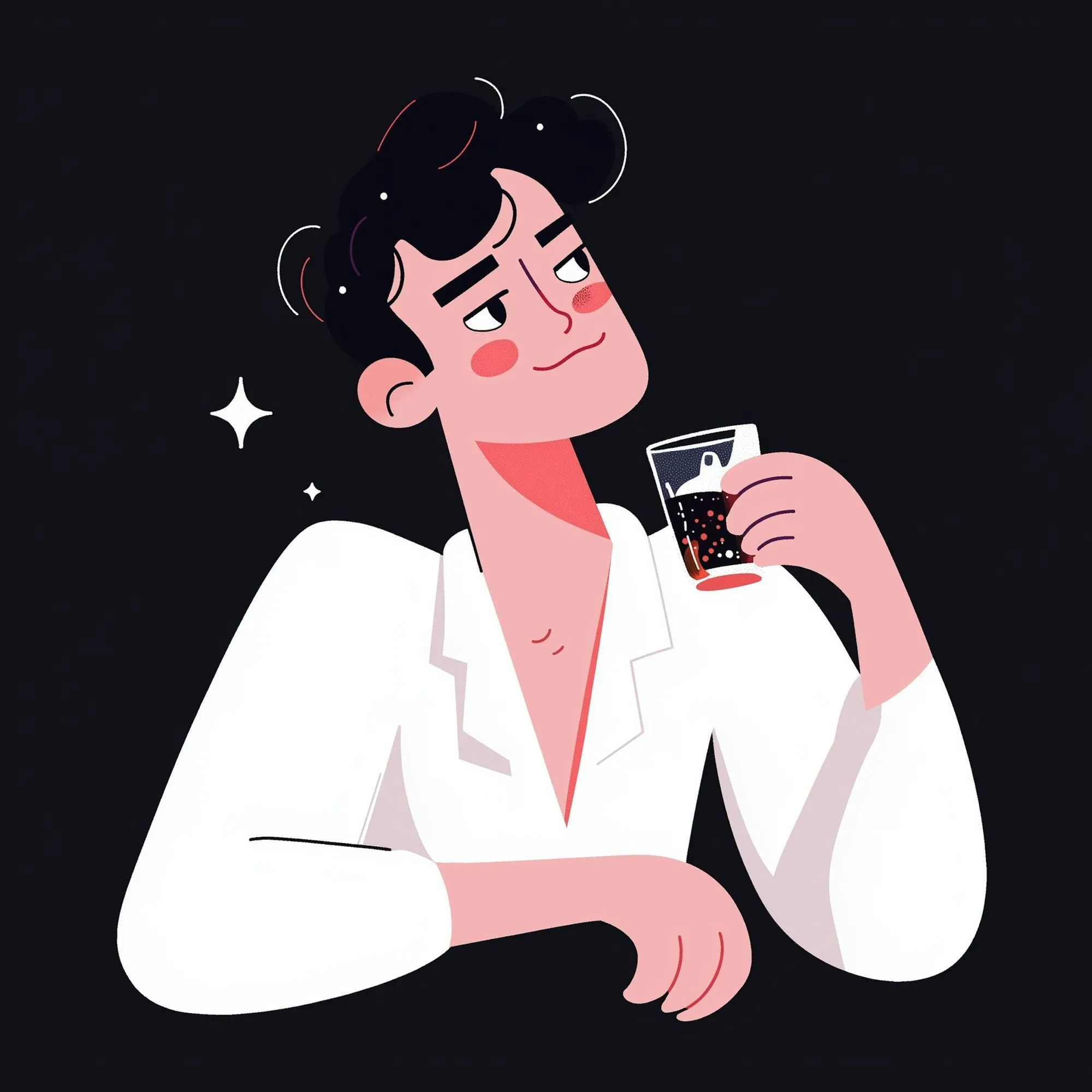How Adobe Firefly Is Transforming Digital Art, Design, and Content Creation
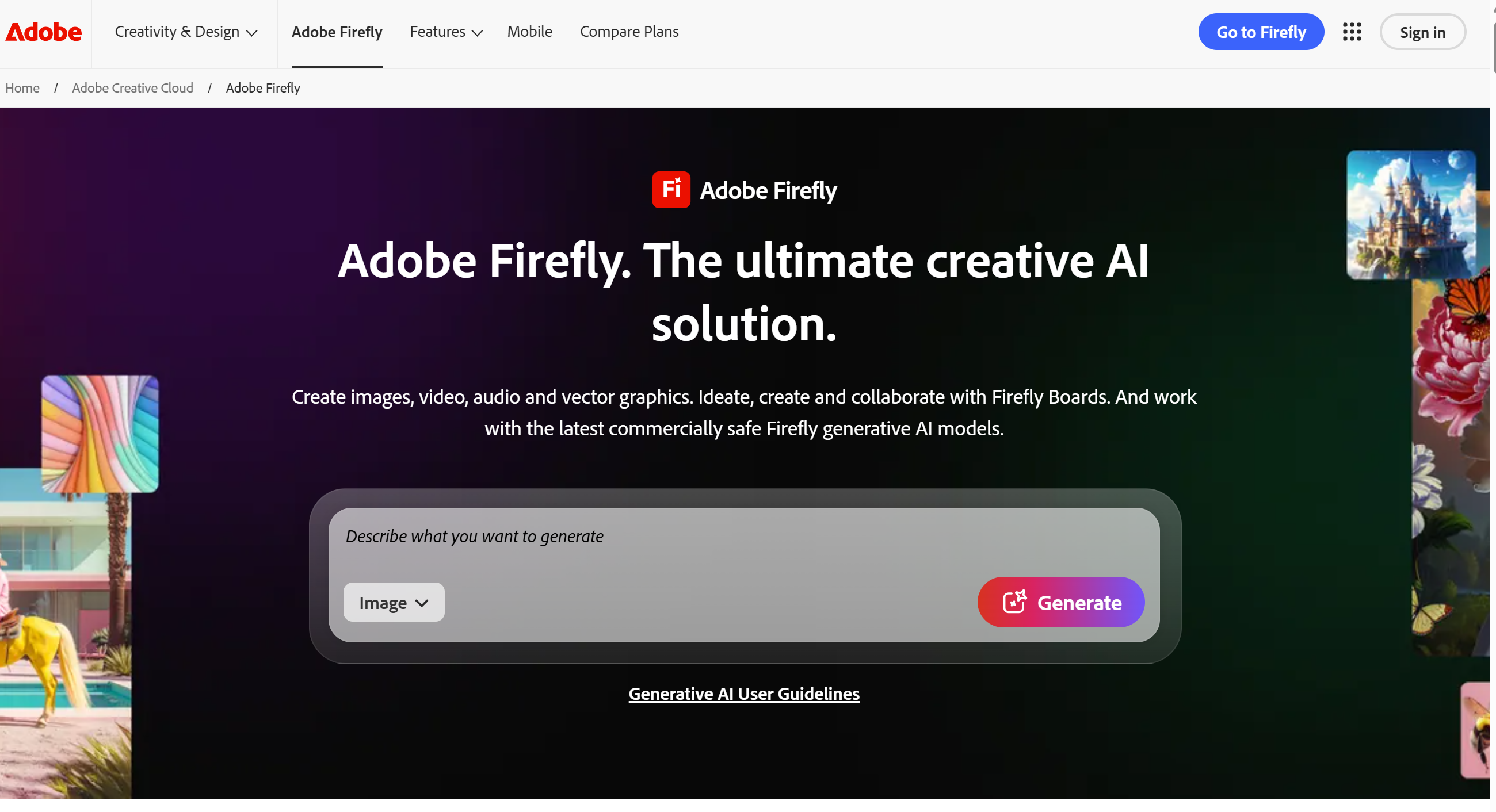
Introduction: The New Age of AI-Powered Creativity
Artificial Intelligence isn’t just changing how we work—it’s transforming how we imagine, create, and express. In 2025, creative industries are experiencing one of the biggest paradigm shifts in decades. Tools like Adobe Firefly, Midjourney, and Runway are democratizing creativity, giving designers, marketers, and even non-creatives access to studio-grade art generation in seconds.
Until recently, creative workflows were time-intensive. You’d spend hours refining images in Photoshop, sourcing stock photos, or outsourcing visuals to design teams. Now, AI-powered image generation platforms like Adobe Firefly have condensed that process into minutes—sometimes seconds—without sacrificing quality or artistic intent.
According to Bloomberg Intelligence, the global generative AI market is projected to surpass $1.3 trillion by 2032, with creative design accounting for one of its fastest-growing verticals. Adobe, already a titan in the creative software space, has seized the moment with Firefly, a tool that merges creativity with automation through natural language prompting, ethical training data, and seamless integration into Adobe’s ecosystem.
For modern creators and businesses alike, choosing the best AI design software isn’t about replacing human creativity—it’s about amplifying it. Adobe Firefly embodies that balance perfectly. As part of App Genie AI’s exploration of human–AI collaboration, this article dives into the technology, use cases, and implications of Firefly’s rise in shaping the future of design.
What Is Adobe Firefly and How Does It Work?
At its core, Adobe Firefly is a generative AI design tool built to help users create images, videos, and text effects through simple natural-language prompts. It’s Adobe’s answer to the growing dominance of independent AI tools like Midjourney, DALL·E 3, and Canva AI—but with a critical difference: Firefly is trained entirely on licensed and commercially safe content.
That means designers can confidently use Firefly’s outputs for marketing, advertising, and commercial work without fearing copyright infringement—something few competitors can guarantee.
A Quick Overview of Firefly’s AI Engine
Under the hood, Firefly is powered by Adobe Sensei GenAI—a multimodal framework that combines machine learning, computer vision, and natural language processing. It runs on Firefly’s proprietary model trained on Adobe Stock, public domain images, and openly licensed datasets.
Unlike other tools that rely on scraped internet data, Adobe’s approach aligns with its Content Credentials Initiative, which prioritizes ethical AI training and intellectual property protection.
⚙️ Key Technical Components
- Generative Fill: Allows you to add, remove, or extend parts of an image intelligently using text prompts.
- Text-to-Image Generation: Converts textual descriptions into detailed visuals, from realistic landscapes to stylized illustrations.
- Vector Recoloring: Lets illustrators instantly modify color palettes while preserving shape and contrast.
- Generative Recolor for Adobe Illustrator: Seamlessly transforms flat artwork into vibrant, gradient-rich visuals.
According to Statista, Adobe Creative Cloud surpassed 30 million subscribers by 2025, many of whom now have direct access to Firefly inside applications like Photoshop, Illustrator, and Express. This deep integration makes Firefly not just another standalone AI tool—it’s part of a creative ecosystem.
Comparison: Adobe Firefly vs Other AI Art ToolsFeature
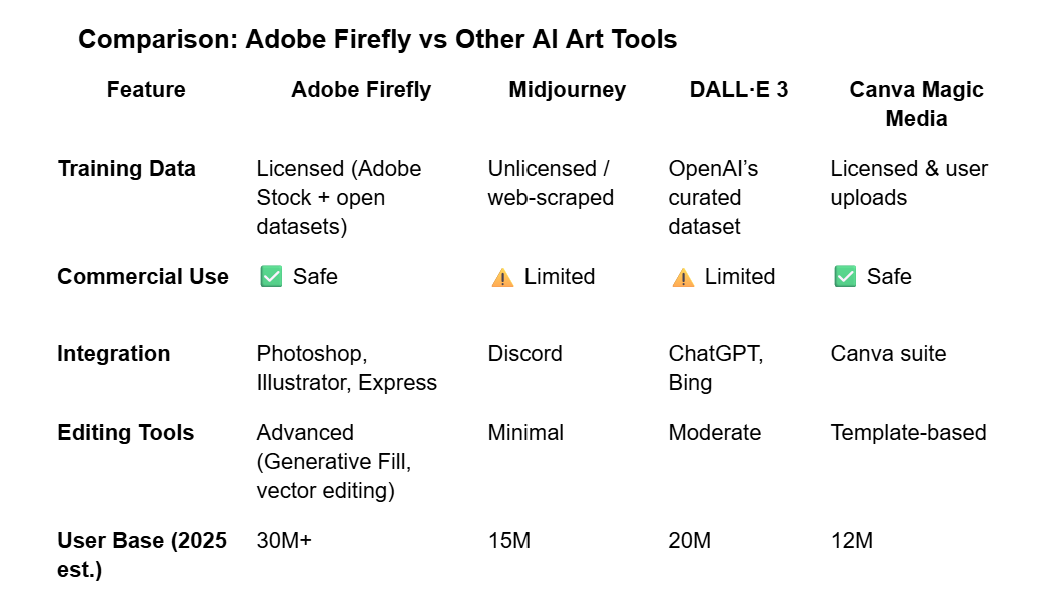
What makes Firefly particularly powerful is its cross-app adaptability. A single generated image can be refined in Photoshop, animated in After Effects, and published directly through Adobe Express—all while retaining generative edit layers.
As AI creative design software, Firefly’s strength lies in its ability to maintain brand consistency, stylistic control, and legal safety, which are often lacking in its open-source competitors.
What Makes Firefly Different from Other AI Art Tools?
The most common critique of AI-generated visuals has been their inconsistency or lack of emotional nuance. Firefly addresses this through precision prompting and semantic understanding—its model doesn’t just interpret the literal prompt; it understands creative context.
For instance, when you type:
“Create a futuristic city skyline at sunset, cinematic lighting, 8K detail”
Firefly will generate multiple visually cohesive compositions, each consistent in lighting and tone, with no distorted structures or incorrect physics—a common problem in earlier AI generators.
Unlike Midjourney, which outputs stylized results through Discord-based commands, Firefly feels intuitive and visual. Its Smart Image Reference feature lets users upload an image as a stylistic anchor—Firefly then matches colors, lighting, and mood. This has made it one of the most realistic AI art creators available today.
Moreover, because it’s embedded within the Adobe ecosystem, Firefly doesn’t disrupt traditional workflows—it enhances them. Designers can move seamlessly between prompt-based generation and manual refinement, bridging creativity and control.
How Adobe Firefly Is Changing Digital Design Workflows
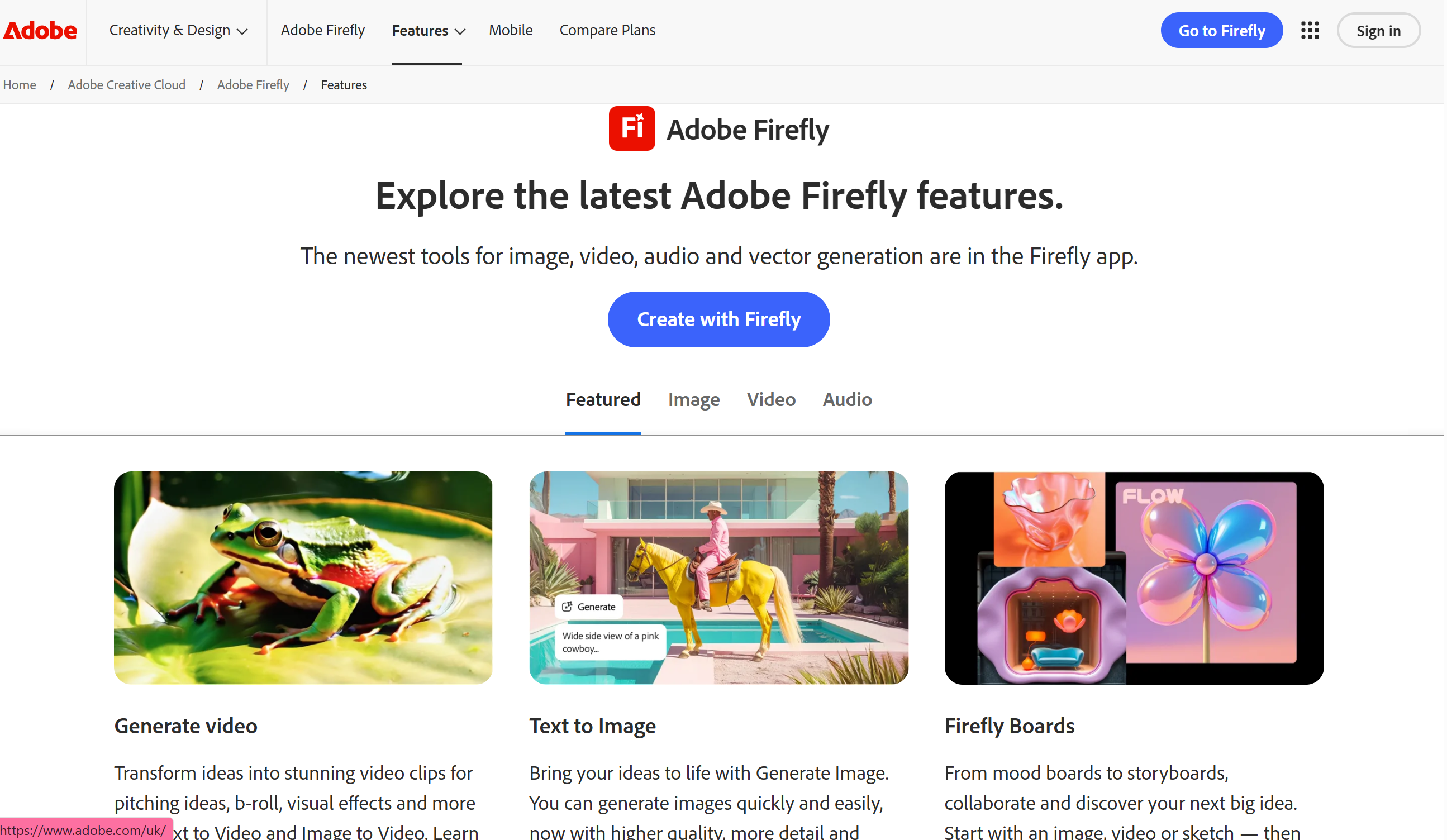
The beauty of Adobe Firefly lies not only in what it creates but in how it changes the process of creation. Whether you’re a seasoned designer or a marketer with no formal design background, Firefly empowers users to produce high-quality visuals that align with their brand and storytelling goals.
Generative Fill — A Game-Changer for Designers
The Generative Fill tool has become one of the most viral features introduced by Adobe. With a single brush stroke and text prompt, users can extend backgrounds, remove unwanted elements, or even alter environments entirely—without complex layering or masks.
This feature, first launched in Photoshop Beta (2023), is now integrated across Photoshop 2025, Illustrator, and Adobe Express.
According to Adobe’s official blog, Generative Fill has increased editing speed by up to 80%, allowing designers to spend more time conceptualizing and less time retouching.
From e-commerce image cleanup to cinematic concept design, Generative Fill is redefining what “post-production” means. And for marketing teams, it’s a revolution—one designer can now do the work of three, freeing creative bandwidth for strategy and innovation.
Firefly for Photoshop — Reimagining the Creative Process
Adobe Firefly for Photoshop is the bridge between prompt-driven AI and manual craftsmanship. Users can highlight a specific section of an image, describe what they want to appear, and Firefly intelligently integrates the new content with perfect lighting, texture, and depth.
The 2025 Adobe Creative Trends Report found that creative teams using Firefly reduced production time by up to 60% on average. That’s not just productivity—it’s a complete reimagining of the workflow pipeline.
Unlike other AI generators that output static images, Firefly integrates directly into the PSD editing layers, meaning all changes are reversible and editable. This level of control is crucial for professional designers handling brand-sensitive projects.
📊 Stat Snapshot:
45% of marketers now use AI-generated visuals in campaigns — HubSpot Marketing AI Report, 2024
By combining automation with human refinement, Firefly enhances—not replaces—the creative role. This positions Adobe Firefly as a true AI-powered video and image creation workflow tool rather than a gimmicky visual generator.
Empowering Non-Designers and Professionals Alike
One of Firefly’s most significant achievements is democratizing creativity. With its text-to-image generator and intuitive interface, anyone can produce professional-level designs without technical expertise.
For small business owners or social media managers, this levels the playing field. You don’t need to hire a full design team to create engaging ad banners or content visuals—just describe your vision, and Firefly makes it real.
At App Genie AI, we view this shift as the natural evolution of human-AI collaboration: AI handles the technical heavy lifting, while humans steer creativity and storytelling. This dual model represents the future of creative workflow optimization with AI.
And for professional designers, Firefly isn’t a shortcut—it’s a creative co-pilot. It helps ideate faster, test multiple styles, and build storyboards that would otherwise take days. In short, Firefly helps creators spend less time in production mode and more time in vision mode.
The Role of Adobe Firefly in the Future of AI Art

Artificial Intelligence has officially become the co-creator of the 21st century. And in 2025, Adobe Firefly is no longer just an “AI feature” inside Photoshop — it’s the creative backbone redefining the entire design industry.
The modern creative professional doesn’t just open Photoshop anymore — they talk to it. Through natural language prompts, Firefly turns written imagination into high-quality, editable images, text effects, and even animated concepts.
This evolution reflects a broader cultural shift: AI is no longer competing with artists. It’s collaborating with them.
Generative AI in Graphic Design — Data-Driven Growth
Design has always been about speed, precision, and visual storytelling — and AI is enhancing all three.
According to Canva’s 2025 Design Trends Report, 69% of graphic designers now use generative AI tools weekly, primarily for ideation, layout creation, and creative brainstorming. Adobe’s internal metrics show similar adoption spikes, with Firefly integrated into 90% of new Photoshop installations globally as of early 2025.
For agencies and in-house design teams, this shift is seismic. Where a single campaign could take two weeks to storyboard, Adobe Firefly can produce draft concepts in under an hour — with editable PSDs ready for client approval.
It’s not just about productivity; it’s about possibility. Firefly’s text-to-image and Generative Fill features empower creatives to iterate endlessly, testing styles, lighting moods, and compositions without wasting time on repetitive manual work.
📊 Did You Know?
The average design project turnaround has dropped by 45% since 2023, largely due to AI integration in creative workflows (McKinsey Digital Productivity Index, 2024).
Semantic Keyword Tie-In: This marks the most tangible evolution of generative AI in graphic design — an era where software isn’t just a tool but a collaborator with a creative voice.
AI Creativity in Digital Art — Beyond Automation
If 2023 was the year of AI experimentation, then 2025 is the year of AI expression.
With Adobe Firefly, digital artists can move beyond repetitive prompt experimentation to true artistic direction.
Firefly’s precision lies in its Seedream 3.0 model, which captures fine details like lighting gradients, motion direction, and texture fidelity. For concept artists, this means you can go from written script to cinematic-quality artwork in one iteration.
Unlike other text-to-image systems, Firefly preserves character integrity and environmental coherence across frames — which makes it perfect for sequential or narrative art.
As App Genie AI often emphasizes, AI doesn’t diminish originality—it expands it. Tools like Firefly amplify human intent, letting imagination scale without the friction of technique.
According to Statista’s 2025 Creative Industry Analysis, over 47% of professional artists report using AI tools like Firefly, Runway, or Midjourney to assist in sketching, rendering, and refining compositions — not to replace artistry but to accelerate it.
That’s the beauty of AI creativity in digital art: it automates execution while keeping emotion and storytelling firmly in human hands.
Why Firefly Is More Than a Tool — It’s a Bridge Between Worlds
Firefly stands out because it doesn’t operate in a vacuum. It’s integrated into tools creatives already use daily — Photoshop, Illustrator, and Express — bridging the gap between static design, dynamic motion, and scalable content production.
For instance:
- Advertisers use Firefly to rapidly generate multi-format ad variants.
- Film pre-visualization teams use it to storyboard in 3D without hiring illustrators.
- E-commerce brands rely on Firefly for realistic product mockups at scale.
This hybrid ecosystem makes Adobe Firefly a cornerstone of creative workflow optimization with AI. It’s not an isolated AI sandbox; it’s a unified creative suite.
And while Midjourney excels at aesthetics and DALL·E shines in abstraction, Firefly wins in functionality and commercial safety — a key differentiator for enterprise users.
“AI won’t replace creators — it will empower them to create faster and smarter.”
— Shantanu Narayen, CEO, Adobe Inc. (Adobe MAX Keynote, 2024)
Ethical Use and Responsible AI in Design
Every major innovation in technology comes with a moral responsibility — and AI-generated art is no exception.
In the last two years, the design community has grappled with the question: Can machines be creative without being exploitative?
Adobe Firefly’s answer: transparency, traceability, and training integrity.
The Ethics of AI Art Generation
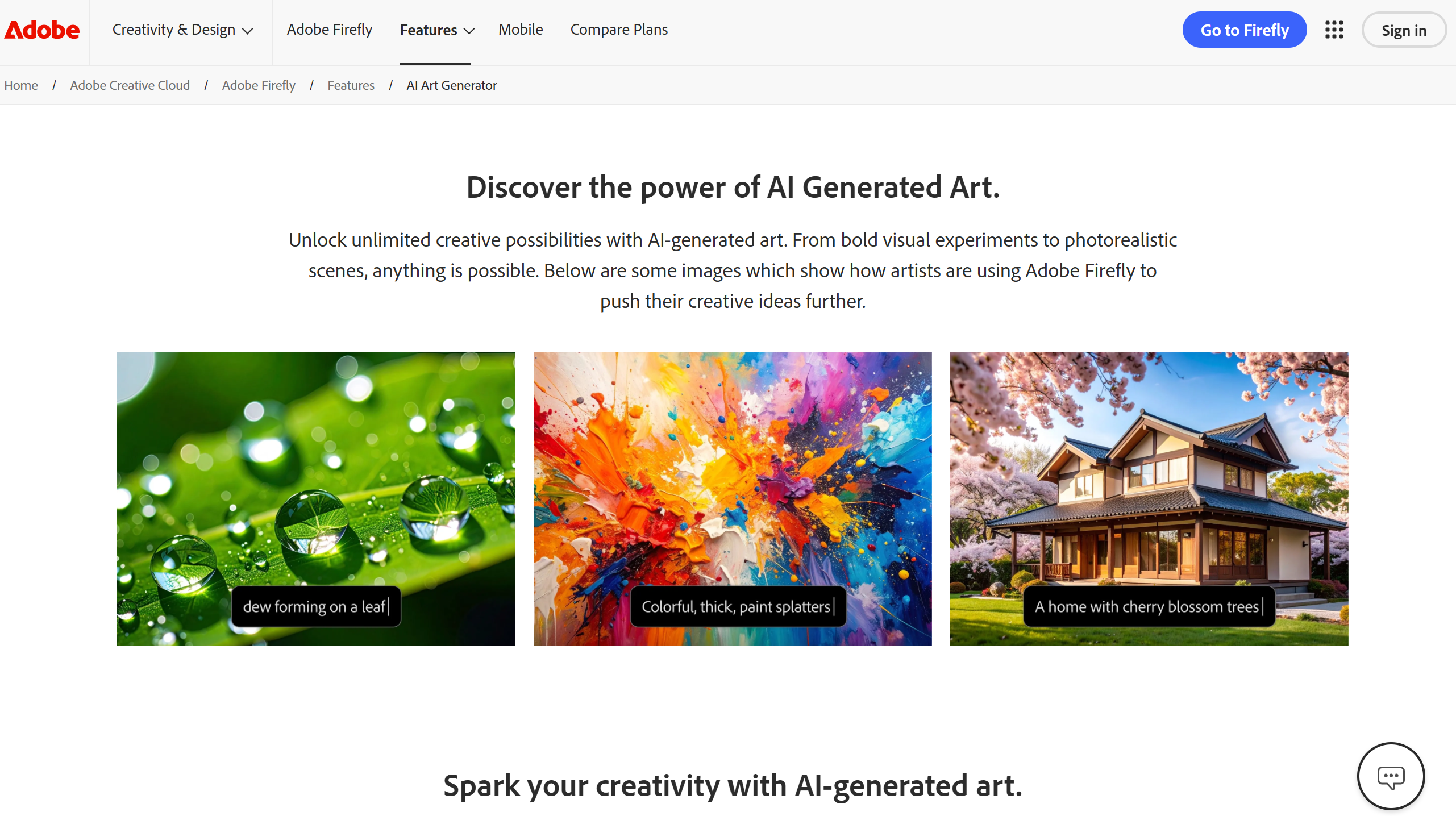
A common criticism of generative AI tools is that many models are trained on copyrighted datasets without consent. This creates blurred lines around ownership and plagiarism.
Adobe, to its credit, took a radically different route. Firefly was trained exclusively on licensed content from Adobe Stock, along with public domain and Creative Commons datasets. This means every image generated is commercially safe, with no hidden copyright risks.
The company also launched its Content Credentials Initiative, which embeds metadata signatures into AI-generated works. This allows audiences, publishers, and clients to see exactly when, where, and how AI was used.
This is critical as the creative world pushes toward responsible AI in design.
A Pew Research Center survey in 2024 found that 78% of creators worry about their work being used without permission by AI companies — a concern Adobe Firefly directly addresses through consent-based datasets.
Semantic Keyword Tie-In: This proactive approach makes Firefly a benchmark for the ethical use of AI in design—something no other platform has yet matched in scope or reliability.
Copyright and Fair Use in the AI Era
In traditional design, copyright was straightforward: if you made it, you owned it.
AI changes that dynamic. Who owns an image co-created by an algorithm trained on millions of prior artworks?
Adobe’s legal model keeps it simple.
- Commercial safety: Everything generated with Firefly is safe for business use.
- Transparency: All AI outputs come with embedded metadata indicating their generative origin.
- Opt-out consent: Artists contributing to Adobe Stock can choose whether their images are included in Firefly’s training set.
This puts Firefly years ahead of other systems like Midjourney and Stable Diffusion, which still face lawsuits over unauthorized data use.
For businesses and creators in the Search Conversions ecosystem, this kind of clarity is invaluable — it builds trust in AI-driven marketing content and establishes ethical baselines for future creative tools.
Firefly’s Commitment to Responsible Innovation
What truly sets Adobe apart is its long-term vision for responsible AI.
At Adobe MAX 2024, the company revealed its AI Principles Charter, emphasizing:
- Transparency in AI training and output.
- Human accountability in creative workflows.
- Respect for artists’ intellectual property.
Firefly’s underlying models also feature data provenance tracking — meaning Adobe can identify the origin of training data if ever questioned. This transparency framework has been praised by Harvard Business Review as “a model for sustainable AI governance.”
In essence, Adobe Firefly doesn’t just lead in generative capabilities—it leads in ethics, compliance, and trust.
How AI Is Transforming Creative Industries
The impact of tools like Firefly goes beyond art and design; it’s redefining how entire industries create and communicate.
Let’s look at how different sectors are leveraging Firefly in 2025:
1. Marketing and Advertising
According to Gartner’s 2025 CMO Report, 82% of marketing teams now use generative AI to produce visuals, copy, or campaign layouts.
Firefly’s Generative Fill and Template Builder features let marketers instantly customize brand visuals, maintain consistent tones, and produce content 70% faster.
For digital agencies working with Search Conversions-style performance frameworks, this speed translates directly into higher conversion rates and improved ROI through agile content testing.
2. Film and Entertainment
Production studios use Firefly’s image-to-video features for pre-visualization, replacing what used to be entire storyboarding departments.
Its Video 3.0 Pro model can turn static prompts into cinematic sequences — a game-changer for pre-production.
This is fueling an estimated $9 billion creative automation market within entertainment by 2027 (PwC Media Outlook, 2024).
3. E-commerce and Product Design
Brands now use Adobe Firefly to prototype product designs, test packaging variations, and visualize ad campaigns before they’re even produced.
For example, a fashion retailer can use text prompts like:
“Generate a minimalist product photo of leather sneakers on a marble surface, warm lighting.”
Firefly instantly renders the result—no photographer, no studio, no physical inventory required.
That’s creative scalability in action—and it’s only accelerating.
4. Education and Learning
Educators are using Firefly for visual storytelling, lesson illustrations, and creative writing aids.
In Adobe’s 2025 Classroom AI Initiative, over 1.2 million students used Firefly to produce visual essays and design projects, helping bridge the gap between creativity and learning accessibility.
5. Enterprise Design Systems
Large corporations—especially in tech and fintech—are integrating Firefly directly into enterprise-grade design systems.
This ensures brand-safe automation for content localization, advertising personalization, and digital asset management.
McKinsey estimates that by 2026, creative automation powered by AI could save enterprises up to $280 billion annually in design and marketing costs (McKinsey AI Productivity Study, 2024).
Optimizing Your Creative Workflow with AI
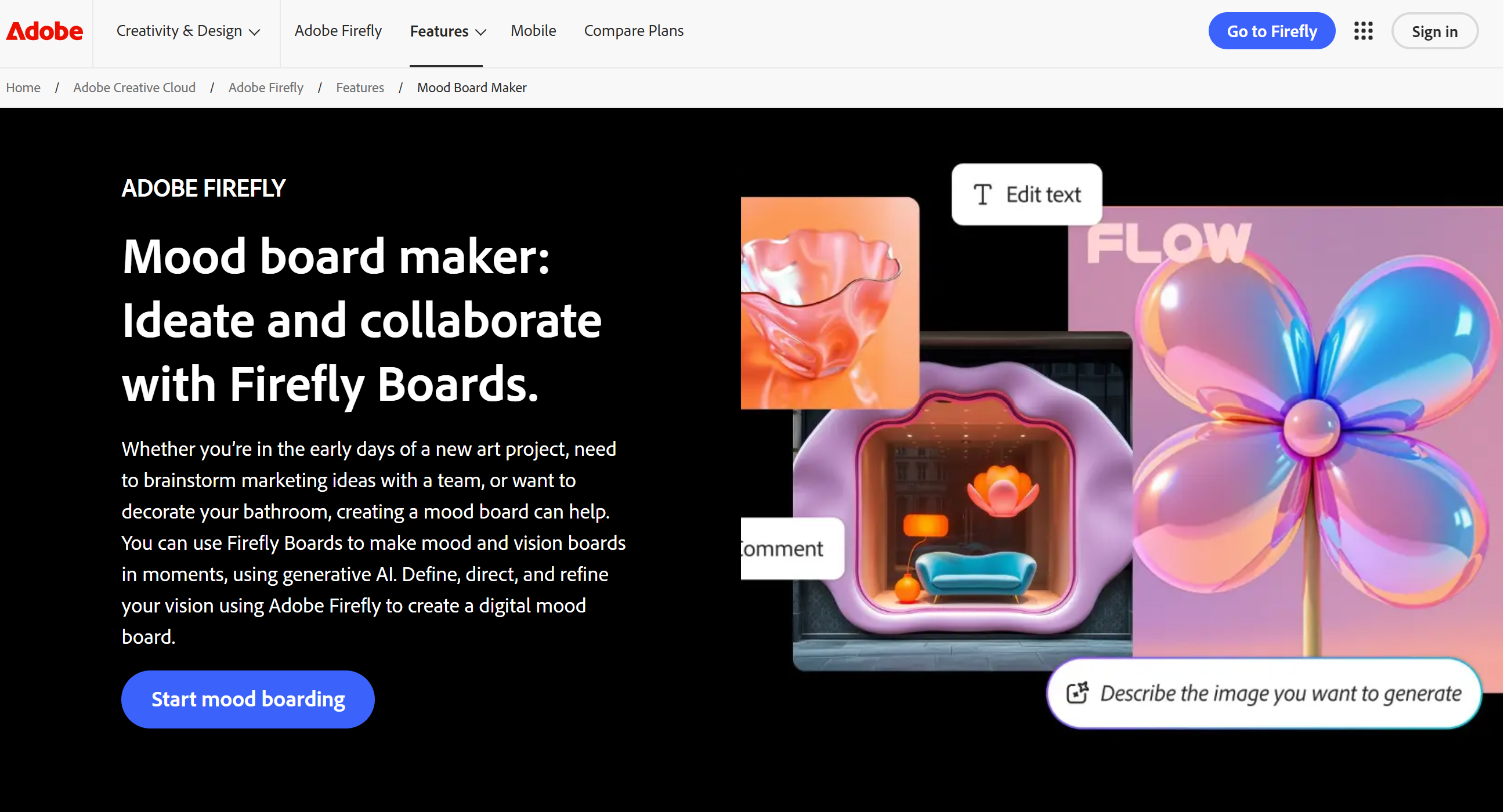
The most powerful promise of Adobe Firefly is not just what it creates — but how it transforms the way we create.
Whether you’re a solo designer, a marketing team, or a digital agency, integrating Firefly into your workflow can dramatically cut down production time and amplify creative output.
Step-by-Step: How to Integrate Adobe Firefly into a Modern Creative Pipeline
Step 1: Ideation and Concept Generation
Start with prompts that capture your vision. For example:
“Design a futuristic workspace for a sustainability startup, minimalist aesthetic, natural light.”
Within seconds, Adobe Firefly’s text-to-image engine generates multiple versions, each ready for refinement.
This eliminates the “blank canvas” problem that slows down creative professionals.
Step 2: Visual Refinement and Collaboration
Once you select your preferred version, bring it into Photoshop or Illustrator.
Use Generative Fill or Vector Recolor to tweak elements — adding depth, adjusting composition, or experimenting with palettes.
Step 3: Brand Consistency Across Platforms
If you’re a marketer, import your assets into Adobe Express. Firefly ensures that every image generated aligns with brand guidelines automatically.
This is especially valuable for businesses that manage multi-channel campaigns across social media, email, and ad networks — ensuring consistent visuals at scale.
Step 4: Automation and Scaling
For enterprises, Firefly integrates with Adobe’s Firefly API, allowing automated generation of localized or variant ad creatives in seconds.
This is where creative workflow optimization with AI becomes measurable ROI.
📊 According to McKinsey’s 2024 Digital Productivity Study, AI-assisted creative workflows save up to 90% of design time compared to traditional methods (McKinsey Digital).
The Efficiency Impact: A Quick Comparison

These numbers represent more than just convenience — they mark a shift in creative economics.
Design no longer scales with manpower, but with machine intelligence guided by human intuition.
Cross-Functional Collaboration
One of Firefly’s most underrated advantages is how it improves cross-team collaboration.
Marketing, design, and copywriting teams can all work within the same ecosystem — Adobe Creative Cloud — with Firefly serving as the connective AI layer.
This allows creative teams to brainstorm together, test new visuals instantly, and deliver high-quality content faster than ever before.
In fact, Gartner’s 2025 CMO Study found that organizations adopting AI-first creative pipelines reported a 27% increase in content velocity and a 35% boost in campaign engagement.
For a company like Search Conversions, which thrives on performance-driven marketing, this is the future of content agility — AI-powered creativity with measurable business outcomes.
Best Practices for Optimizing Firefly Use
- Craft Clear Prompts: Use descriptive yet concise language to get more relevant results.
- Use Reference Images: Upload existing brand visuals to maintain aesthetic consistency.
- Iterate with Precision: Don’t stop at the first output — Firefly’s strength is in refinement.
- Leverage Adobe Express Templates: Perfect for non-designers creating quick campaigns.
- Monitor AI Outputs: Use Firefly’s built-in Content Credentials to maintain transparency and traceability.
These best practices ensure balance between creative freedom and brand control — a principle that aligns with App Genie AI’s vision of AI-assisted creativity with accountability.
Conclusion — The Future of Adobe Firefly and the AI Creative Movement
As we move deeper into the age of artificial creativity, one truth becomes evident: AI won’t replace artists — it will redefine artistry.
Adobe Firefly exemplifies that philosophy.
It doesn’t attempt to outthink humans; it augments human creativity by providing infinite possibilities at the speed of thought.
A Catalyst for Creative Empowerment
With its ethical dataset, intuitive design, and seamless Creative Cloud integration, Firefly is bridging the gap between imagination and execution.
It empowers:
- Designers to focus on storytelling instead of technical labor.
- Marketers to launch campaigns in hours instead of days.
- Businesses to scale creative output globally without increasing headcount.
In this sense, Firefly isn’t just an AI design software — it’s the engine of creative transformation.
The Broader Industry Impact
By 2027, it’s projected that AI-driven design tools will power 80% of digital marketing campaigns (Forrester AI Marketing Forecast, 2025).
This will create new creative roles: AI design directors, prompt engineers, and visual data curators — professionals who bridge human intent with algorithmic execution.
Firefly’s ethical-first framework also establishes a global standard for responsible generative AI, ensuring that innovation doesn’t come at the cost of originality.
The App Genie AI Perspective
At App Genie AI, we believe the next decade of digital creativity will be defined by synergy — where human intuition meets machine precision.
Tools like Adobe Firefly embody that balance, transforming design from a technical process into a strategic, data-informed collaboration.
For creative teams and marketing professionals under Search Conversions, adopting Firefly isn’t just a tech upgrade — it’s a mindset shift.
It means embracing creative fluidity, leveraging ethical AI, and unlocking scale without sacrificing soul.
Final Thoughts
Artificial intelligence has already changed how we search, shop, and communicate. Now, it’s changing how we create.
With Adobe Firefly, we’re entering a future where creative freedom isn’t limited by tools or training — only by imagination.
“AI doesn’t replace creativity; it expands it.” — Javeria Usman, Founder, App Genie AI
